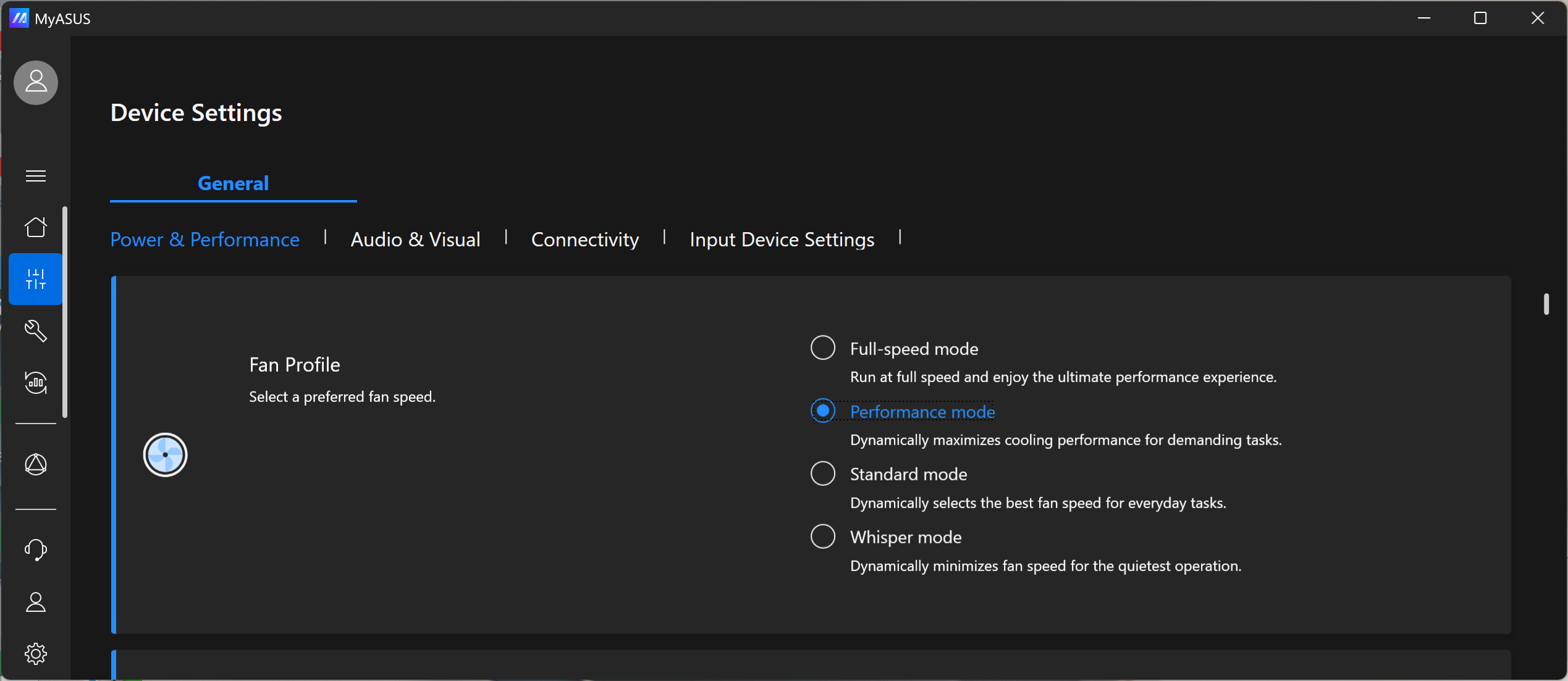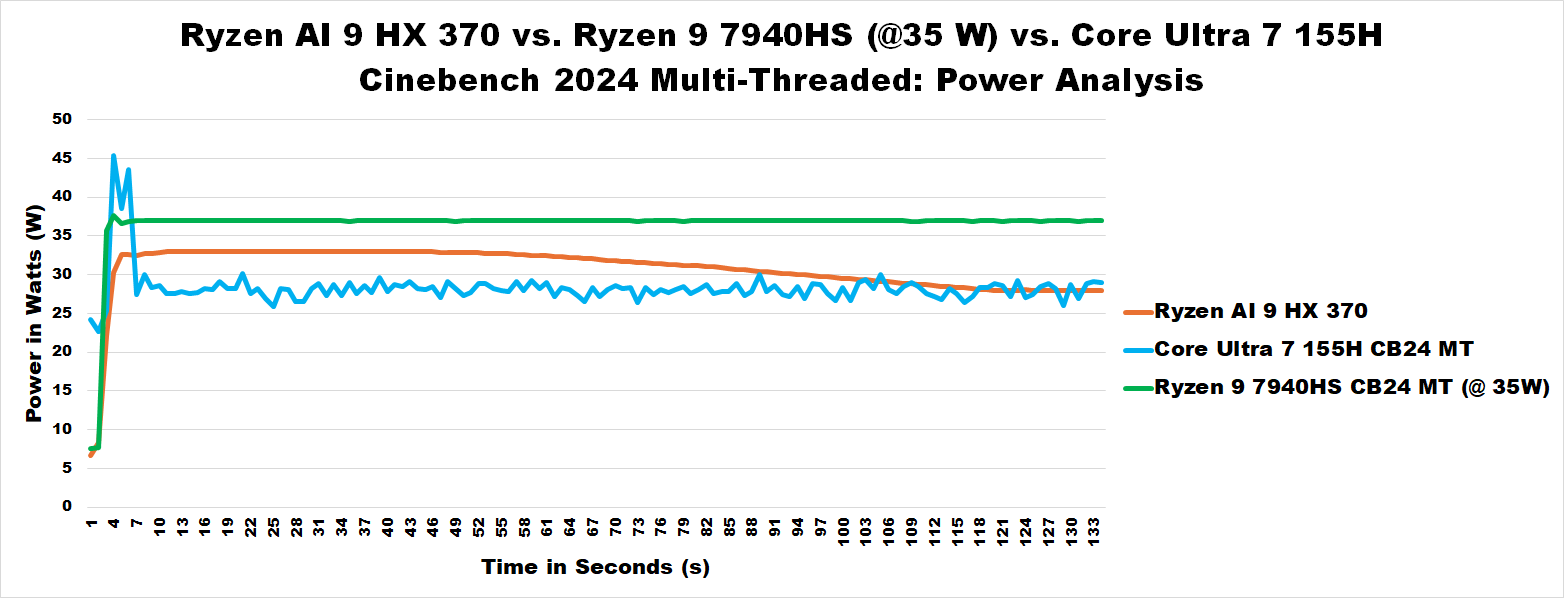The AMD Ryzen AI 9 HX 370 Review: Unleashing Zen 5 and RDNA 3.5 Into Notebooks
by Gavin Bonshor on July 28, 2024 9:00 AM ESTASUS Zenbook S 16: Power Consumption & Performance Modes
A big part of any laptop's performance is its TDP – how much energy the chassis can consistently dissipate – meaning that two laptops can have wildly different performance, despite using the same chip, just by virtue of their cooling capabilities. So measuring the peak and sustained power consumed by a laptop is particularly important, both to get an idea of where it falls on the ultrabook-to-DTR spectrum, but also how a design compares to other laptops. Especially with an architecture launch like this one, we need to know if a performance lead comes from architecture and efficiency, or just running a lot of power through a chip.
The AMD Ryzen AI 9 HX 370 has a rather large configurable TDP range overall, with the chip capable of being set to anything between 15 and 54 W. This gives Strix Point a wide berth to fit in everything from ultrabooks to larger gaming notebooks, but it also means that the chip's performance, particularly in heavily multi-threaded and mixed CPU/GPU workloads is going to be defined by its TDP.
Despite its 16-inch frame, In the ASUS Zenbook S 16 is configured rather conservatively. ASUS has taken what's nominally a 28W chip and dialed it down to 17W for it's out-of-the-box experience. Dubbed "Standard Mode" the out-of-the-box experience is a laptop that's highly efficient and highly quiet, but does leave some performance on the table for the sake of acoustics.
ASUS also gives the user quite a bit of latitude to pick performance modes here, with the Zenbook offering 4 different modes altogether. Besides the standard mode, there's the ultra quiet "Whisper mode", the performant "Performance Mode" with a 28W TDP, and the no-holds-barred "Full-speed Mode".
For most of the Zenbook S 16 you'll see today – ours included – you'll find these laptops are running in the 28 Watt Performance Mode. This comes by request of AMD, who is looking to show off what the chip can do at its standard TDP, rather than ASUS's dialed-down TDP. And while we're not beholden to this (or any other) request from AMD, from a pragmatic standpoint it's a lot easier to find 28W laptops than it is 17W laptops. So for our first round of testing, we have dialed up our laptop to its 28W mode.

In our peak power test, the Ryzen AI 9 HX 370 ramped up and peaked at 33 W. We typically see a higher peak power value than the TDP before things settle down during an intensive workload, although the Intel Core Ultra 7 155H within the ASUS Zenbook 14 OLED did manage to peak at 64 W for a very brief moment, which is way out of spec.
Looking at the power of the Ryzen AI 9 HX 370 when using Maxon's latest Cinebench 2024 (multi-threaded test) benchmark, which is quite an intensive rendering workload, we can see how it compares to the Ryzen 9 7940HS when dialed down to 35W, as well as the Intel Core Ultra 7 155H which is running at 28W within the ASUS Zenbook 14 OLED. Aside from the very large spike up to 45W on the Core Ultra 7 155H, we see a pretty consistent level of power usage from the CPU package (the cores).
Focusing on the Ryzen AI 9 HX 370, we can see it quickly ramped up and achieved a very consistent load level, bouncing between 32 and 33 W throughout the Cinebench 2024 MT benchmark loop. As the benchmarking loop carried on, power consumption slowly dropped to a steady-state TDP of 28W, matching the configured TDP of the laptop. The slow and gradual drop in power towards the end was very smooth. The same can be said about the Ryzen 9 7940HS. In contrast, the Intel Core Ultra 7 155H produces some slightly noisier data, bouncing around between 26.5 W and 29 W throughout the test.












72 Comments
View All Comments
Dante Verizon - Sunday, July 28, 2024 - link
Why are you comparing an ultra-thin design to a CPU with PL2 at almost 90w? The notebookcheck tests show that the Zenbook runs up to 50% slower than the ProArt chassy.Ryan Smith - Sunday, July 28, 2024 - link
Sorry, which notebook are you referring to? We have multiple Zenbooks here.Terry_Craig - Sunday, July 28, 2024 - link
He's probably talking about the Zenbook in the review: https://www.notebookcheck.net/Asus-Zenbook-S-16-la...Strix performs much worse on the Zenbook than inside the ProArt, probably due to more aggressive power and temperature management.
Ryan Smith - Sunday, July 28, 2024 - link
It's definitely not a high performance chassis, despite being 16-inches. The default TDP is just 17 Watts; AMD asked reviewers to bump it up to 28W.But this is what AMD sent out for review. Given the wide range of laptop TDPs out there, these review unit laptops can never cover the full spectrum. So it's more a reflection of what power level/form factor the chipmaker is choosing to prioritize in this generation.
The Hardcard - Sunday, July 28, 2024 - link
What is the 90W laptop in this review? The other laptops are listed at 28W and 35W here. I did not see any indication of the power specifications of the ProArt on the other site, just some numbers provided. I strongly suspect that laptop is running at top TDP, 45-54W.So, like, a different comparison.
Terry_Craig - Sunday, July 28, 2024 - link
https://www.notebookcheck.net/AMD-Ryzen-9-7940HS-P...Depending on the model, the 7940HS goes up to 100w.
The Hardcard - Monday, July 29, 2024 - link
But, is the 7940HS pulling 100w in this review instead of the reported 35w? Otherwise,, what is the point of the complaint?https://www.ultrabookreview.com/69005-asus-proart-...
The HX 370 is in a different chassis pulling 80w sustained. Does that make the 35w vs 28w happening here more fair? I mean, if what the chips can draw elsewhere somehow matters here at all?
eastcoast_pete - Monday, July 29, 2024 - link
It matters if one wants to look at the maximum performance possible, regardless of power draw. But, in addition to what Ryan wrote, the attraction of the HX Series to me is the strong performance at lower power draws. I would have actually liked to see performance comparisons at 17 W, which IMHO is of special interest in such thin and light notebooks. The higher end (> 50 W) will be if interest for Strict Halo, which as far as I can tell is supposed to take on notebooks with smaller dGPUs.ET - Sunday, July 28, 2024 - link
From the benchmarks here, the 370 looks somewhat disappointing on the CPU front, with some losses to 8 cores Zen 4. A hybrid architecture is always a problem. I wonder if future scheduling changes will help or if the small 8MB L3 for the Zen 5c cores is a problem that can't be overcome.The new GPU however looks like a good upgrade over the previous gen.
nandnandnand - Sunday, July 28, 2024 - link
It's hybrid with different cache amounts, but it's also two CCXs instead of one after 3.5 generations of simple 8-cores. It's hard to say what's screwing it up.Phoronix's review was more positive for the CPU. The main benefit is power efficiency:
https://www.phoronix.com/review/amd-ryzen-ai-9-hx-...
The reviews I looked at didn't look too good for the GPU. Maybe it will do better with more power, but what it really needs is memory bandwidth. Hopefully AMD brings some Infinity Cache to its mainstream 128-bit APUs in the future.